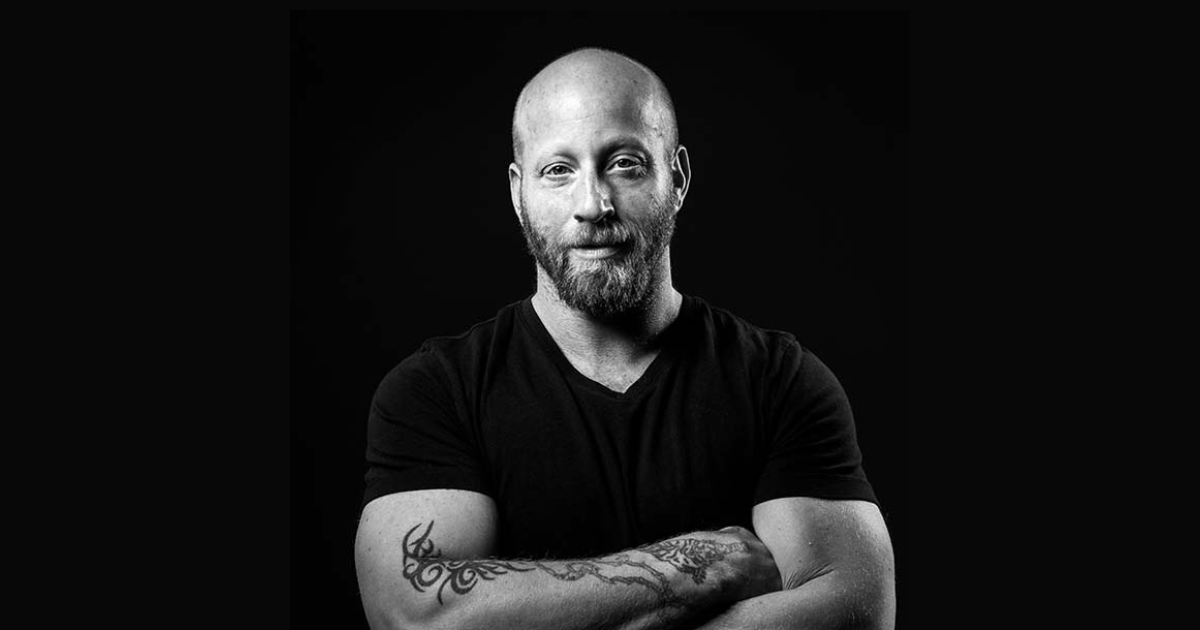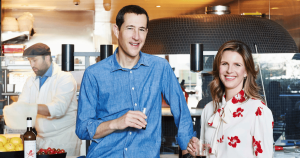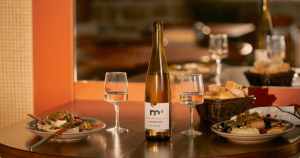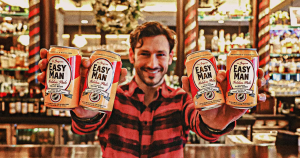Aaron Wisniewski, the visionary founder of Guinep Cocktails, is called the “Indiana Jones of Flavor.” Once you read this Q+A, you’ll understand why. From his passion for the art and science of flavor development to the challenges and triumphs of pioneering in non-alc, this interview offers a fascinating glimpse into Aaron’s creative process.
You’re called the “Indiana Jones” of flavor! Tell us a bit more about your experience as a chef, sommelier, mixologist, and professional flavor designer.
Ha, I love this image! I’ve been obsessed with the art and science of flavor and aroma for a very long time. It’s the lens that has informed my roles as a professional chef, sommelier, and bartender since the beginning of my career in 2001.
My mantra was: “How can I create and preserve aroma?” Since 90% of flavor comes from smell, aroma is the most powerful tool you have in your toolbelt. Since it’s also the only sense directly connected to the memory and emotional centers of our brain, I realized that collecting aromas is akin to collecting memories. So around 2005, I think, I began backpacking around the world between restaurant jobs collecting and bottling aroma and flavor memories. From Makrut Lime leaves in northern Thailand to wild goat musk in Mallorca and woodfired grills in the Yucatan. This was a huge contributor to my success in the food and beverage world, and also fueled a more intense obsession with the science of aroma and flavor.
Over the years, I developed different, more effective ways to analyze and capture smells and flavors and amassed a huge library of global “scent memories.” In 2012, I started Alice & the Magician flavor labs where I used that library to design flavor and aroma products like drinks and cocktail mists. I was even a co-founder of a tech company where we worked to fully digitize our sense of smell. When I gave up alcohol, I recalibrated the focus of my obsession and directed it towards making alcohol-free drinks, lifestyle, and culture more interesting and fulfilling.
You’ve explored unique flavors and ingredients around the world—what are some of the most interesting ones you’ve discovered on your travels?
Obviously guinep would have to be at the top of the list! I was first introduced to it in Puerto Rico during a surf trip. A small, unassuming green fruit that looked like a small lime and grew in backyards and along the beach. I was unprepared for how intensely aromatic and unique the flavor was. I could not stop obsessing over it. I didn’t know at the time what I might do with it, but when I made the decision to create an NA Cocktail, there was no doubt that guinep would be the star of it.
A lot of my flavor experiences stand out because they have shock value. Like drinking fresh snake blood and bile in Vietnam, or eating durian in the Philippines. But what always sticks with me is how much more expressive ordinary things like carrots, basil, or limes are when they are fresh and grown lovingly in ideal conditions. It’s truly transcendent to eat something that tastes just like itself but with the volume turned all the way up to 11.
What was the pivotal moment that led you to create Guinep?
I was on my third “mocktail” of the night at a bar with a bunch of friends. My stomach was so full of juice, my blood sugar was through the roof, and I was clutching my drink trying to “fit in” with everyone else doing shots and I thought to myself, FUCK THIS. I’m tired of drinking juice like it’s a guest pass to the cool kids party. I wanted my own drink and my own culture, and I wanted to feel proud of the decision I made to be alcohol free and not like I was sitting at the kids’ table trying to fit in with the adults. So, I thought I’ll just build it myself. It turns out I wasn’t the only one who felt that way. There were lots of other people having the same feeling and lots of other entrepreneurs who made the same decision to give themselves a seat at the bar. We’re redefining social drinking with us at the center, not on the outside.
How do you source ingredients for Guinep, and what criteria must they meet to align with your brand’s values?
I’ve been designing commercial drinks and flavors for over a decade now and I always think in terms of Flavor, Function, and Culture. Whatever I’m making, it has to:
- taste fucking amazing
- do something positive for the body, mind, community, or planet (other than just taste amazing), and
- be for someone or a group of someones. AKA: what is the cultural significance?
In the case of Guinep, all natural was paramount. Nourishing, not depleting (for body, community, and planet), and sustainable are all non-negotiable.
Can you explain the health benefits of deep ocean minerals and why they are a critical component in your beverages?
I like to talk about the deep ocean minerals in two ways. First the science, and second the romance.
Every cell and biological process in the human body requires micronutrients like minerals and elements. By adding the right combination of minerals and elements, you optimize the performance of the brain and body. Simply put, you just function better on minerals. You can also influence your mood based on mineral intake. Increased Magnesium and Zinc intake, for example, have been linked to decreased feelings of anxiety. The deep ocean minerals we source are a blend of 70 different trace minerals and elements in the perfect proportion to ease stress and anxiety—and to promote overall biological function.
The romantic part is how I fell in love with them in the first place. The ocean water at the depth we get the minerals from doesn’t mix with surface water, so it has remained largely unchanged for hundreds of thousands if not millions of years. It’s the birthplace of life itself, and even though we humans evolved to walk on land, we still carry a piece of that ancient ocean inside us. If the little piece of ocean inside us falls out of balance, we feel physically and emotionally unwell. The deep ocean minerals restore that ancient balance.
In creating an alcohol alternative, what challenges do you face in achieving the depth of flavor typically associated with alcoholic beverages?
Recreating the sensory experience of an alcoholic beverage is unbelievably challenging. Alcohol performs so many functions in the drink. It adds weight, body, and texture. It dissolves and suspends flavor and aroma compounds that have limited solubility. And it evaporates those aroma compounds to give alcoholic drinks the depth of flavor and aroma that’s hard to find anywhere else.
I started with aroma. Guinep has such a distinct, intensely aromatic quality that’s well-suited for an NA drink. Unlike many fruits and botanicals, it contains highly volatile aromatic compounds that are miscible in water, so the drink willingly shows its aromatic character. The body was more challenging. But, by using monk fruit extract, deep ocean minerals (which have a higher density than water), and REALLY finely tuned carbonation levels and bubble size, we could get that weight, roundness, and faint sweetness that alcohol imparts—without using sugar. What we ended up with was an intensely aromatic, medium-bodied drink that I longingly think of as a “classier White Claw for the alcohol-free lifestyle.”
You emphasize a dedication to preserving Earth’s wild places. How does Guinep contribute to this cause?
I owe my health and sanity to the outdoors and that gratitude has become a part of the Guinep DNA. We partner with 1% for the Planet to donate 1% of all sales to environmental non-profits. We source and manufacture sustainably, and we give and volunteer in our communities. Ocean health is a priority for us since we use ocean minerals, and we want to preserve and give more than we take. Closer to home, I support the Green Mountain Club which helps maintain the Long Trail and other Vermont hiking trails so they can remain safe, free, and accessible.
What role does innovation play in product development at Guinep, and can you give an example of how it’s shaped your current product?
I have dedicated my life and my career to pursuing innovations in flavor aroma. From the time I washed my first dish in a professional kitchen at age 13 to the moment I’m writing this sentence, I have been in awe of the impact food and drink have. I approach every day with creativity and curiosity about how to use food and drink in new ways to make our lives better.
At Guinep, we are currently (and always) finding new ways to create better alcohol-free products. For example, we loved the flavor of guinep, but it would be an ecological disaster to try and cultivate and import the fruit itself. So, I used a method I developed to analyze the flavor chemicals of the fruit and recreate it. It’s chemically identical to the real thing, but created using local extracts and essences.
We are developing new flavors and functional ingredients, but actually where we are innovating the most these days is in community building. More and more people are cutting down on (or giving up) alcohol. Or, they have a desire to do so but that journey is filled with loneliness and confusion. How do we build a meaningful community? What is the future of social drinking? What does a fulfilling alcohol-free life look like and how can we support that? We are trying to answer these questions for ourselves, and also for everyone else out there on this journey.
Are there any upcoming product launches that Guinep enthusiasts can look forward to?
We’re going to be focusing on “Guinep Classic” for the foreseeable future, but we have a really exciting list of launches that I’m DYING to tell you about. I will keep those mysterious for the time being.
What’s your vision for the future of the non-alcoholic beverage industry, and where does Guinep fit within that vision?
This is semi-controversial, but I think alcohol is following the same path that tobacco and cigarettes did over the last 10 – 20 years. There is no longer any question that alcohol is terribly unhealthy for us, and I can’t imagine us going on drinking like we have been, knowing this. I doubt it will disappear, but I think social drinking will evolve and we’ll get to maybe a 50/50 balance of alcoholic and NA consumption. Then, the severe divide between alcohol and alcohol-free will dissolve. Just like vegan and gluten-free options co-exist effortlessly with traditional menu options, so will alcohol-free options. The decision to not drink is currently a “big” decision that is noteworthy when expressed at a bar or restaurant. Soon, it won’t even register for people.
To be clear, I am not “anti-alcohol.” Nor am I against “altering your mind.” Alcohol just seems like such an unhealthy substance to consume regularly when there are so many better options that taste great, make you feel great in the moment, but also make you MORE healthy and productive instead of less. Like we say all the time at Guinep, “it’s time to enjoy the night AND look forward to the morning.”
___
Dry Atlas is your guide to the world of alcohol alternatives. We maintain the world’s largest directory of non-alcoholic spirits, wines, beers, and more to help you discover options you’ll love. We also publish High Spirits, the weekly newsletter that helps open-minded drinkers like you learn more about non-alc. Our goal is to demystify alcohol alternatives so you can navigate them with ease to pursue a happier, healthier life.






